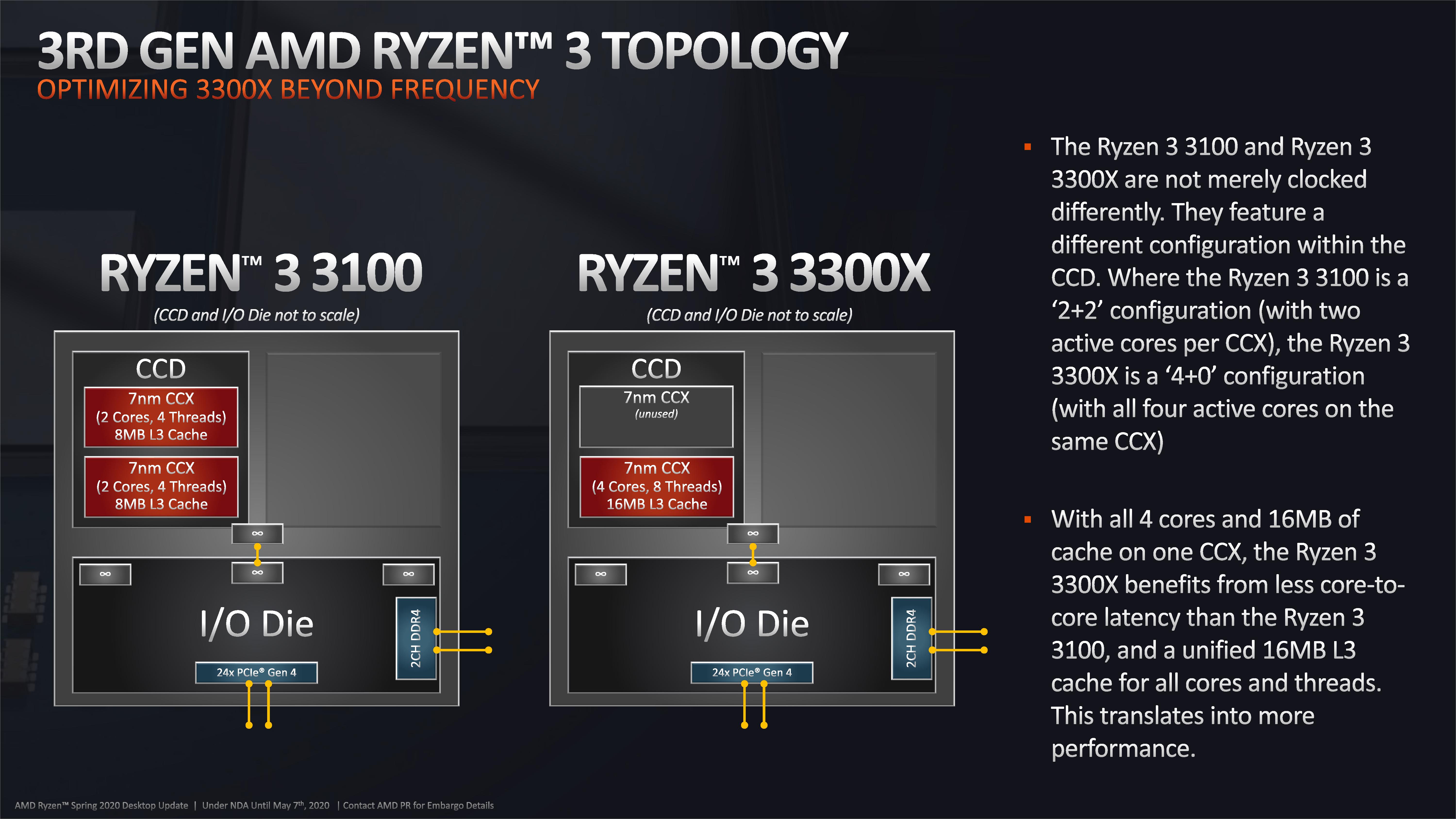Tom's Hardware Verdict
The Ryzen 3 3300X and 3100 bring a new class of gaming performance to the low end, serving up enough performance for high-end gaming while leaving room in the budget for a better GPU.
Pros
- +
Low pricing
- +
Great gaming performance
- +
Solder TIM
- +
Overclocking ceiling
- +
PCIe 4.0 interface
- +
Power efficient
Cons
- -
Lackluster bundled cooler
Why you can trust Tom's Hardware
The Ryzen 3 3300X and Ryzen 3 3100 show how much the AMD vs. Intel CPU landscape has changed since AMD's Zen first arrived three years ago. At the time, the mainstream desktop had been stuck at four cores for a decade, and Intel's market-leading $350 Core i7-7700K served as the halo part. Now AMD's new four-core, eight-thread Ryzen 3 3300X beats the 7700K in every benchmark across the board—but for only $120, making it a natural fit for our list of best CPUs and the best value gaming chip on the market. Our Ryzen 3 samples also reached the highest all-core frequencies we've seen with a Ryzen processor yet, underlining the untapped potential for enthusiasts.
The company's new Ryzen 3 has Intel's Core i3 and i5 in the crosshairs. While the Zen 2 architecture and 7nm process have given AMD the core count lead in both the mainstream and HEDT segments, its previous low-end lineup isn't quite as impressive compared to Intel's existing Core i3 processors. That's a situation AMD hopes to rectify with its Ryzen 3 series as it braces for Intel's looming Comet Lake launch.
The 3300X serves as Ryzen 3's new flagship part with four cores, eight threads, a 3.8 GHz base and 4.3 GHz boost, plus unified core design for a mere $120. AMD says this chip tackles Intel's $157 six-core/thread Core i5-9400F and provides 20% more performance, which would be quite the feat.
The $99 Ryzen 3 3100 is the next step down the price ladder with four cores and eight threads and a 3.8 / 3.9 GHz base/boost frequency, but it's a steep step down on performance due to a different distribution of cores across the chiplet. In either case, AMD says this chip is 20% faster than the $120 quad-core/thread Core i3-9100 in gaming and has 75% more performance in threaded productivity work, making the 3100 a price-to-performance hero in its own right.
| Row 0 - Cell 0 | MSRP | Cores / Threads | Base / Boost GHz | TDP | L3 Cache | PCIe |
| Ryzen 9 3950X | $749 | 16 / 32 | 3.5 / 4.7 | 105W | 64MB | 16+4 Gen4 |
| Ryzen 9 3900X | $499 | 12 / 24 | 3.8 / 4.6 | 105W | 64MB | 16+4 Gen4 |
| Ryzen 9 3900 | N/A | 12 / 24 | 3.1 / 4.3 | 65W | 64MB | 16+4 Gen4 |
| Ryzen 7 3800X | $339 | 8 / 16 | 3.9 / 4.5 | 105W | 32MB | 16+4 Gen4 |
| Ryzen 7 3700X | $329 | 8 / 16 | 3.6 / 4.4 | 65W | 32MB | 16+4 Gen4 |
| Ryzen 5 3600X | $249 | 6 / 12 | 3.8 / 4.4 | 95W | 32MB | 16+4 Gen4 |
| Ryzen 5 3600 | $199 | 6 / 12 | 3.6 / 4.2 | 65W | 32MB | 16+4 Gen4 |
| Ryzen 5 3500X | ~$190 | 6 / 6 | 3.6 / 4.1 | 65W | 35MB | 16+4 Gen4 |
| Ryzen 3 3300X | $120 | 4 / 8 | 3.8 / 4.3 | 65W | 16MB | 16+4 Gen4 |
| Ryzen 3 3100 | $99 | 4 / 8 | 3.8 / 3.9 | 65W | 16MB | 16+4 Gen4 |
AMD's Ryzen 3 silicon is just the start of the value prop, though. The chips come with AMD's generally lax segmentation, so you get hyper-threading on both chips (which forced Intel to match with its upcoming processors), a bundled Wraith Stealth cooler (which could be better, honestly), and unlocked multipliers that enable overclocking on almost all AM4 chipsets (except A320). You will need a beefier cooler for serious overclocking with the 3300X, though. You also get access to the PCIe 4.0 interface, which unlocks twice the connectivity bandwidth of comparable Intel chips, and AMD has its upcoming price-conscious B550 motherboards that support the interface. Still, you'll have to wait until June for those.
We're used to the claims of the world's fastest gaming chips for the halo desktop PC processors, but the Ryzen 3 3300X is unequivocally the best value we've seen for gamers on a budget, particularly if you're looking to build a sub-$1000 system. It also serves up plenty of performance for typical desktop PC work, too.
Ryzen 3 3300X and Ryzen 3 3100 Specifications and Pricing
Before we jump into the speeds and feeds, it's important to know that there's a big architectural difference between the Ryzen 3 3300X and the 3100, giving the former a big boost in gaming and other latency-sensitive workloads that extend beyond the incremental clock improvements we see on the spec sheet. We'll dive into that a bit further down the page, but the Ryzen 3 3300X came up as a far superior chip in our testing, particularly in gaming. In short, it's well worth spending the extra $20 on.
Get Tom's Hardware's best news and in-depth reviews, straight to your inbox.
| Budget | MSRP/Retail | Cores / Threads | Base / Boost GHz | $-Per-Core/Thread | L3 Cache | TDP | PCIe | Memory | Graphics |
| Core i3-10320 | $154 | 4 / 8 | 3.8 / 4.6 | ~$39 / ~$19 | 8 | 65W | 16 Gen3 | Dual DDR4-2666 | UHD 630 1.15 GHz |
| Core i3-10300 | $143 | 4 / 8 | 3.7 / 4.4 | ~$36 / ~$18 | 8 | 65W | 16 Gen3 | Dual DDR4-2666 | UHD 630 1.15 GHz |
| Core i3-10100 | $122 | 4 / 8 | 3.6 / 4.3 | ~$31 / ~$15 | 6 | 65W | 16 Gen3 | Dual DDR4-2666 | UHD 630 1.1 GHz |
| Ryzen 3 3300X | $120 | 4 / 8 | 3.8 / 4.3 | ~$30 / ~$15 | 16 | 65W | 24 Gen4 | Dual DDR4-3200 | N/A |
| Core i7-7700K | $350 | 4 / 8 | 4.2 / 4.5 | $44 / $22 | 8 | 91W | 16 Gen3 | Dual DDR4-2400 | UHD 630–1.15 GHz |
| Ryzen 3 3100 | $99 | 4 / 8 | 3.8 / 3.9 | ~$25 / ~$12 | 16 | 65W | 24 Gen4 | Dual DDR4-3200 | N/A |
| Core i5-9400/F | $182 / $157 | 6 / 6 | 2.9 / 4.1 | ~$30 / ~$30 | 9 | 65W | 16 Gen3 | Dual DDR4-2666 | N/A |
| Core i3-9350K/F | $184 / $174 | 4 / 4 | 4.0 / 4.6 | $46 / $46 | 8 | 91W | 16 Gen3 | Dual DDR4-2666 | UHD 630 1.15 GHz |
| Ryzen 3 3400G | $150 / $207 | 4 / 8 | 3.7 / 4.2 | $37.5 / $19 | 4 | 65W | 8 Gen3 | Dual DDR4-2933 | RX Vega 11 1.4 GHz |
| Core i3-9100/F | $122 / $78 | 4 / 4 | 3.6 / 4.2 | $31 / $31 | 6 | 65W | 16 Gen3 | Dual DDR4-2400 | UHD 630 1.1 GHz |
| Ryzen 3 3200G | $99 / $95 | 4 / 4 | 3.6 / 4.0 | $25 / $25 | 4 | 65W | 8 Gen3 | Dual DDR4-2933 | RX Vega 8 1.25 GHz |
The new 65W Ryzen chips lower the bar for entry to Zen 2 from $199 with the Ryzen 5 3600 to $99 for the Ryzen 3 3100. The Ryzen 3 chips serve up plenty of performance from their four cores and eight threads, but you'll need to step up a tier to the six-core 12-thread Ryzen 5 3600 (or higher) if you're looking for intense performance in threaded productivity apps, multitasking, or game streaming/recording.
But if you're focused on gaming with a discrete GPU and mainstream types of applications, the Ryzen 3 processors fit the bill with surprisingly high base clocks that rival Intel's finest Comet Lake chips. The adaptive Precision Boost 2 clocking mechanism also serves up the best performance possible given your other components, like the cooler, power supply, and motherboard. Both chips come with 16MB of L3 cache (more info below) and support for up to DDR4-3200 memory at stock settings. The same Ryzen 3000 dual-channel DDR4 memory controllers carry over, so memory overclocking is simple and a known quantity. AMD's Eco Mode, which unlocks better power/thermal efficiency by downshifting to a lower TDP tier (35W in this case), also looks promising with the 65W Ryzen 3 models.
If you're looking for a processor with integrated graphics, AMD has its previous-gen Zen+ based architecture paired with the RX Vega graphics engine in its Ryzen 5 3400G and Ryzen 3 3200G APUs. Still, their processing cores aren't nearly as fast as the Zen 2 cores in the new Ryzen 3 models. Instead, they focus on super low-end gaming. AMD's pending (though not yet officially announced) Ryzen 4000 APUs for the desktop will come with the Zen 2 architecture in the future.
We're on the cusp of Intel's Comet Lake launch, and early indicators are that Intel will prioritize its high-end processors, so the lower-end chips that fall into the same bracket as Ryzen 3 won't be immediately available. That leaves us with a bit of time before we can see the full impact of Intel's addition of higher clock frequencies and hyper-threading to the Core i3 lineup, in effect creating its own 'new' Core i7-7700K for the low end with its $154 Core i3-10320.
But as we often see, Intel's pricing sticks out here. You'll have to dip down further to the $122 Core i3-10100 to find the 3300X price equivalent, and it comes with a lower base frequency and less L3 cache. You'll have to drop down to Intel's Pentium lineup to find a sub-$100 chip that matches the Ryzen 3 3100, though the Core i5-9100F can be found on sale at times. And you'll need new boards for those Intel chips, with the new LGA 1200 socket, while AMD's offerings will drop into any number of existing AM4 motherboards.
Intel's Comet Lake chips do look competitive from a performance standpoint, but the company inexplicably discarded its overclockable Core i3 processor for this generation. As you'll see today, the overclockable Coffee Lake Refresh i3-9350K is a powerful gaming chip once you dial up the voltage and clocks, but the Ryzen 3 3300X is beastly in its own right: We achieved a 4.5 GHz overclock. That makes Intel's decision to get rid of an overclockable Core i3 model a possible Achilles heel.
Ryzen 3 3300X and 3100 Zen 2 Architecture
AMD's typical Zen 2 desktop architecture consists of up to two chiplets (CCD), each housing eight 7nm cores, that are tied to a 12nm central I/O Die (IOD) via the Infinity Fabric. AMD simply disables or enables cores based on the SKU, so this basic design comprises chips from four to 16 cores. This scalable approach also extends out to eight chiplets (64 cores) for data center chips, but AMD only uses a single CCD for the Ryzen 3 processors.
AMD splits each CCD into two four-core clusters called Core Complexes (CCX), and the Ryzen 3 3100 has two active cores present on each CCX (2+2). That means it's 16MB of L3 cache is split across two separate slices (2x8MB), which introduces latency, and inter-core latency is higher, too. That slows down latency-sensitive applications, like games and applications with heavy thread dependencies.
In contrast, Ryzen 3 3300X's four cores are resident on a single CCX (4+0), so it has a single 16MB slice of L3 cache and inter-core latency is lower. As you'll see throughout our game suite, that speeds up performance tremendously. We'll also dive into a few cache and mesh latency measurements on the following page.
This approach helps AMD in the die-binning process, with die with four fully-functional cores in a single CCX heading to the premium bin, while the lesser-quality die with defects spread across both CCXs can ship as value silicon. Instead of paring back the silicon, AMD uses the same IOD for these chips as it does with the regular dual-CCD models, and also uses the same CCDs. That means the new Ryzen 3 chips have a total of ~199mm2 of silicon with ~5.99 billion transistors.
While the clustered core approach lends the 3300X the upper hand in performance, it also creates thermal density issues when overclocking. That's because the four cores aren't spread as evenly across the full integrated heat spreader (IHS), creating difficulties dissipating the heat that's generated in a comparatively small area.
AMD's new chips use Solder TIM to improve overclocking potential. As expected, we found that a capable liquid cooler can open up the heights of overclocking, but the 3300X's thermal density could hamper the maximum achievable frequency with some coolers. In either case, we reached 4.5 GHz, a record for our lab with ambient cooling and a Ryzen 3000-series processor (without disabling cores). However, we weren't able to accomplish any meaningful overclocking with AMD's Wraith Stealth cooler that will ship with the Ryzen 3 CPUs.
AMD B550 Motherboards for Ryzen 3 3300X and 3100
AMD's long-overdue and hotly-anticipated B550 chipset, which offers a lower price of entry for PCIe 4.0-capable motherboards, lands on June 16 with up to 60 models from the likes of MSI, Asus, Gigabyte, and the usual roster of other vendors. Pricing isn't confirmed yet, but early signs point to much better pricing than the existing X570 platform that's currently the only pathway to PCIe 4.0 support with a Ryzen 3000 chip.
That leaves Ryzen 3 3300X and 3100 customers with a few options for now. You could drop the chips into the less-expensive B450 or X470 platforms and sacrifice PCIe 4.0 support in exchange for lower pricing, or you can purchase a pricey PCIe 4.0-capable X570 motherboard that isn't a good pairing for this class of chip. Otherwise, you'll have to wait for June to get the best of both worlds with the B550 chipset.
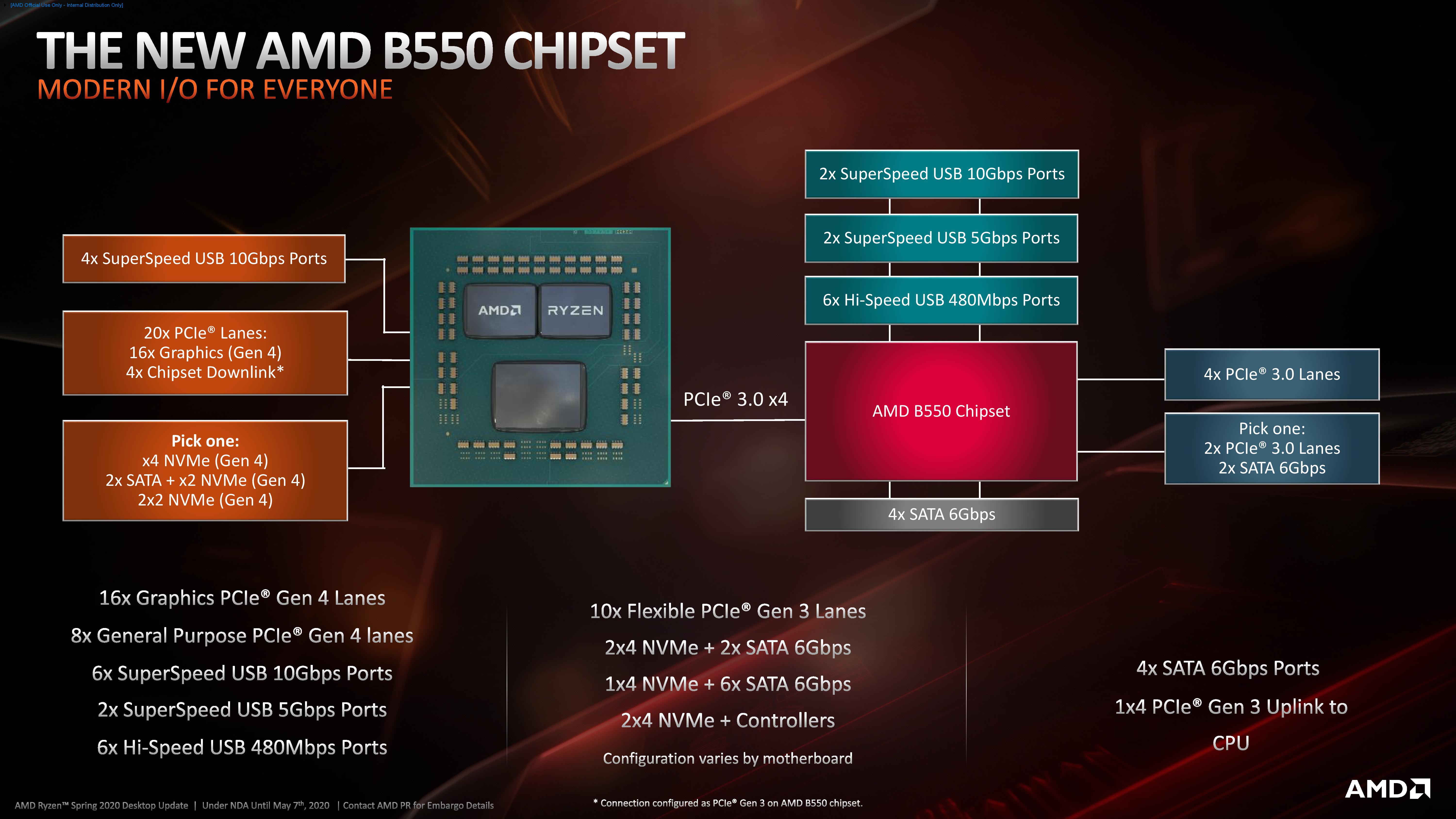
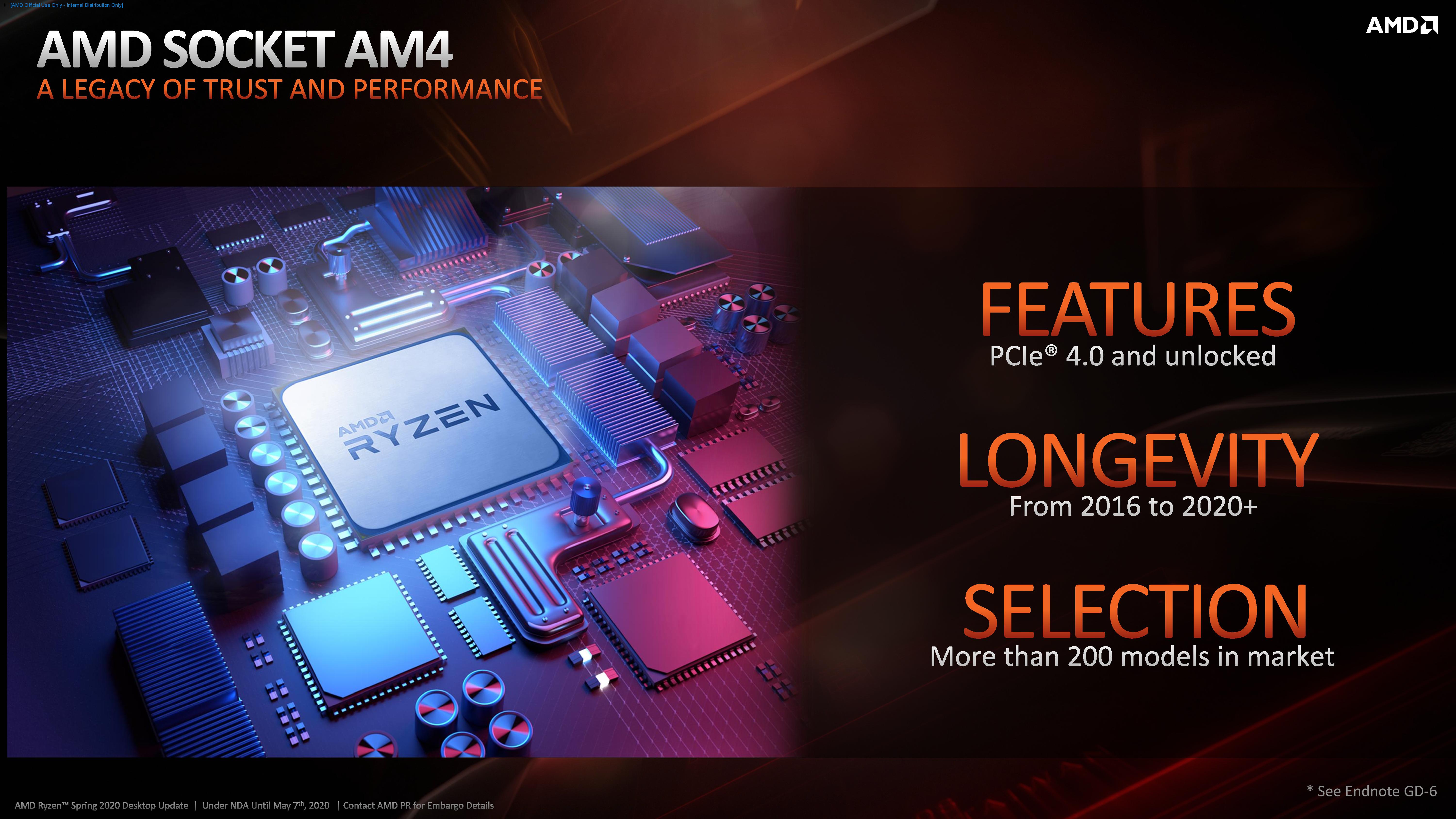
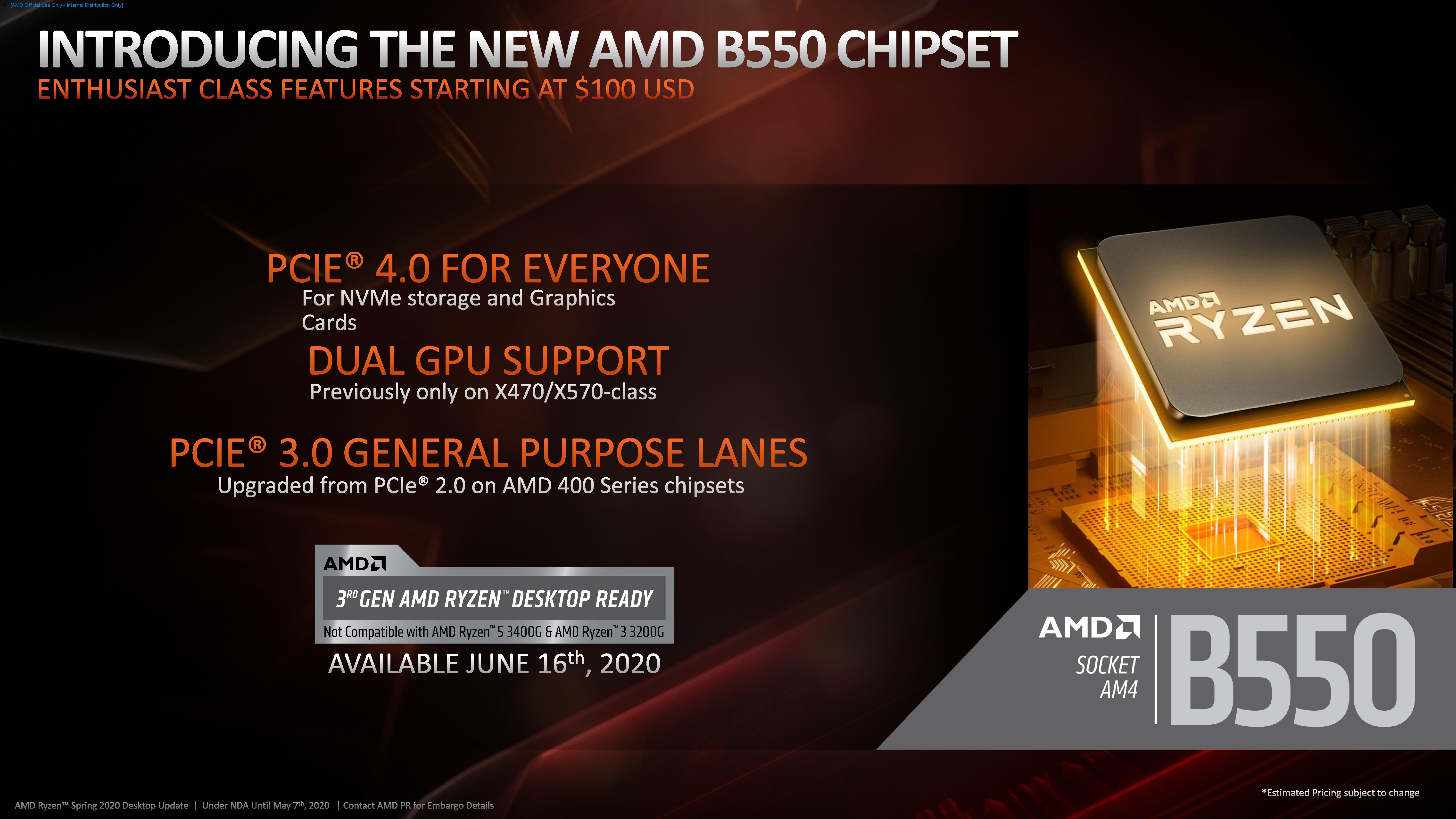


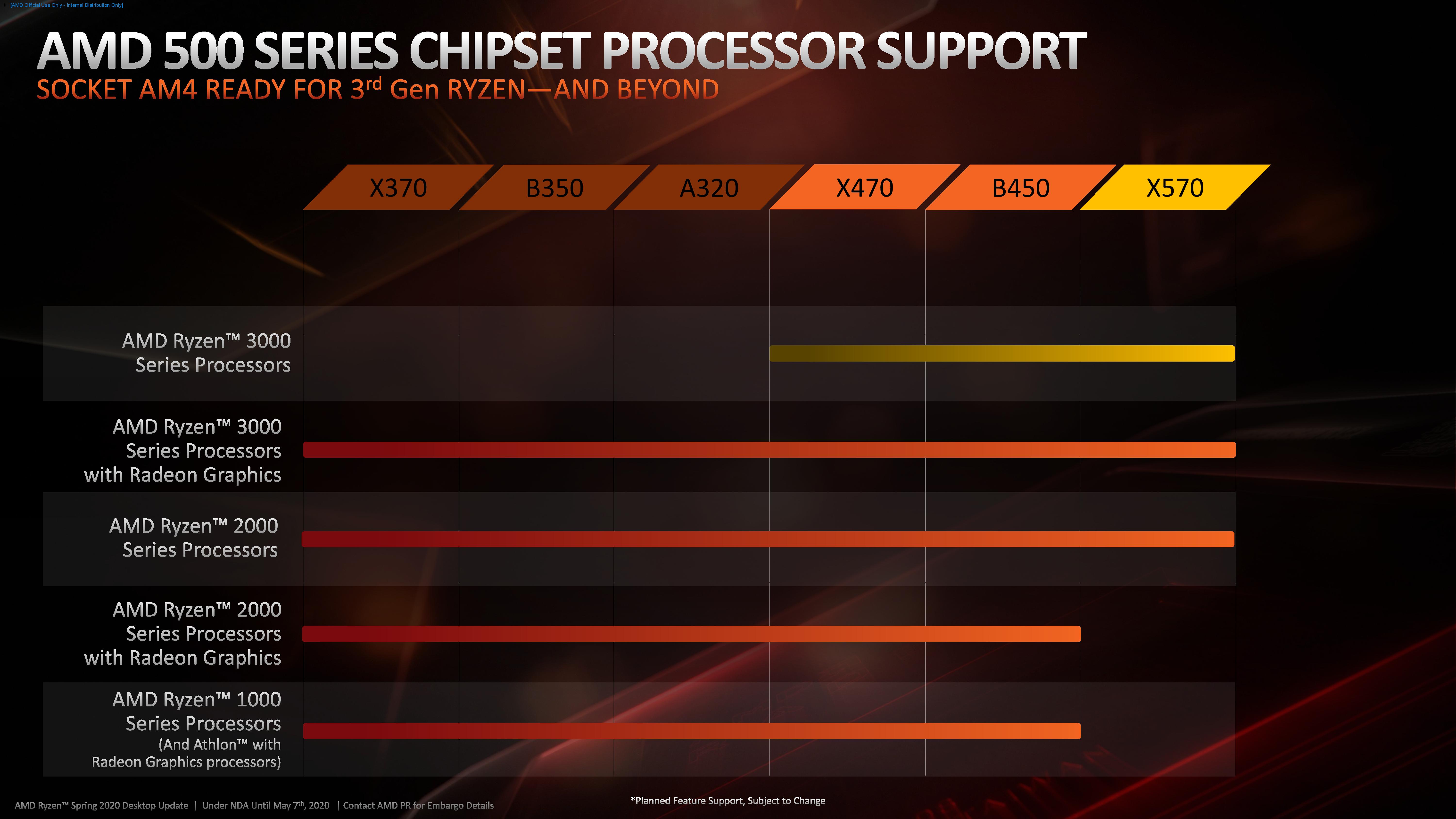
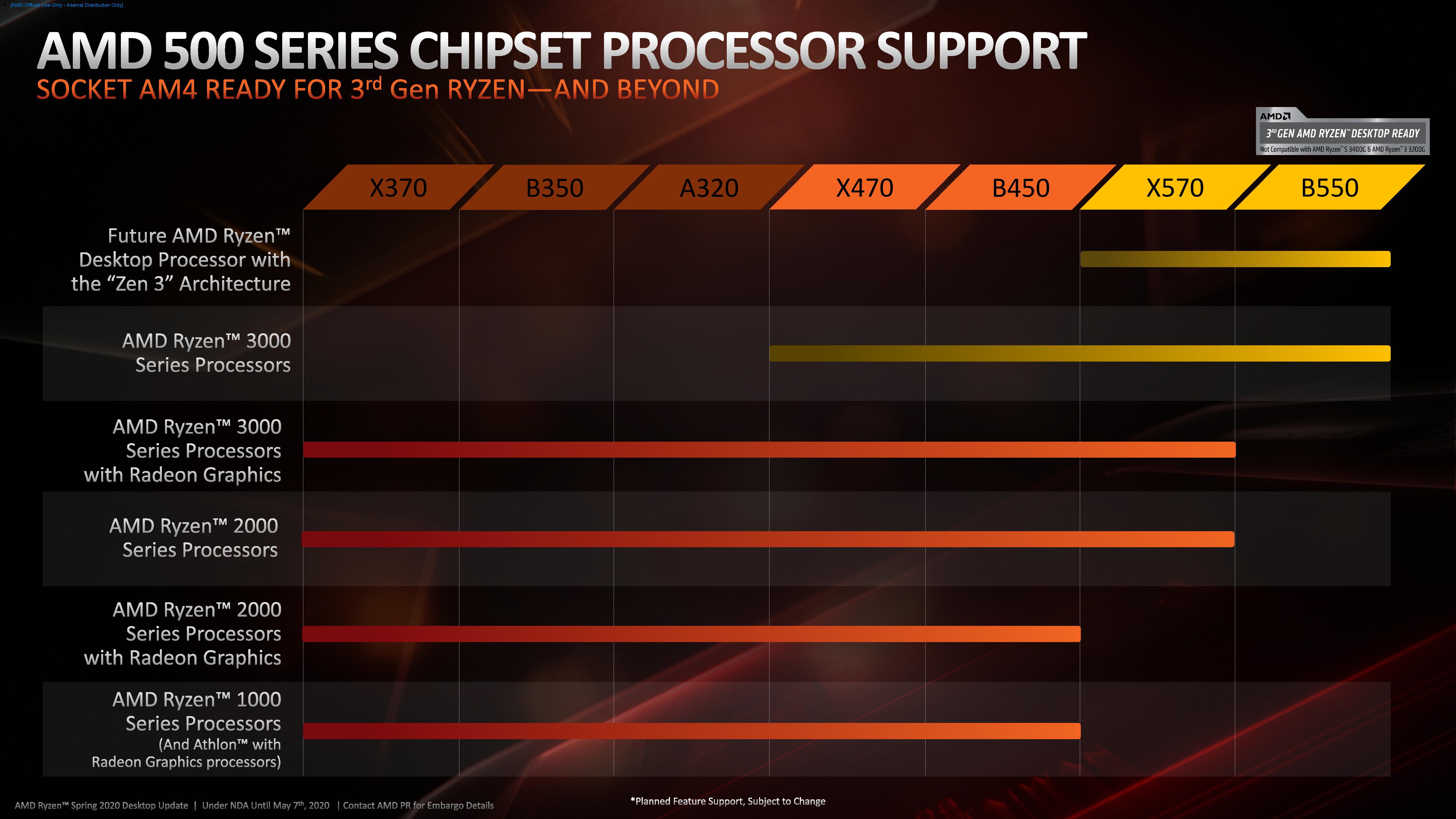
The Ryzen 3 3300X has 16 PCIe 4.0 lanes for graphics and an additional four PCIe 4.0 lanes for storage (M.2 SSD) direct to the CPU, with four more PCIe lanes linking the CPU with the chipset. With B550, AMD also threw in support for dual-GPU configurations on its mid-range motherboards, a first, and upgraded the six general-purpose PCIe 2.0 lanes that hang off the chipset to four lanes of PCIe 3.0. The chipset also now supports USB 3.2 Gen2.
The B550 chipset brings plenty of advantages, including support for CPU and memory overclocking, but there’s a big trade-off. Due to BIOS ROM capacity limitations, B550 motherboards will only support current- and future-gen Ryzen processors. That means pre-Zen 2 processors aren't compatible, which includes the current-gen Ryzen 5 3400G and Ryzen 3 3200G APUs.
This isn't an entirely surprising move. AMD has stuck to its pledge to support the AM4 socket until 2020 but has had compatibility difficulties (particularly with lower-end boards) as it expands its ever-growing roster of motherboards. That's led to varying levels of chip support on different motherboards, which can be confusing due to the wild variation in support matrices from different motherboard makers. Instead of supporting previous-gen chips on B550 platforms and disabling the functionality later, AMD chose to make a hard cut at the Ryzen 3000 series.
That leaves the B550 chipset without support for entry-level APUs, but the company strongly hints that the Ryzen 4000 "Renoir" desktop APUs will come to market by early next year.
Current page: Brace for the Low-End Impact
Next Page Overclocking, Boost, Power and Thermals, Infinity Fabric Latency and Test Setup
Paul Alcorn is the Editor-in-Chief for Tom's Hardware US. He also writes news and reviews on CPUs, storage, and enterprise hardware.
-
InvalidError If we take Intel's stock 7700k as a placeholder for 10th-gen i3s, looks like Intel will have some more catching up to do with AMD's stock 3300X.Reply -
AlexTSG Just a correction for the first page in the Specifications and Pricing section:Reply
...but you'll need to step up a tier to the six core 12-thread Ryzen 5 3600...
Great article. I'm surprised how well the 3300X does in particular. It seems like AMDs biggest competition for these CPUs will be from it's own Ryzen 5 1600AF. -
King_V Hmm, you know, if I were building an AM4 system today, the 3300X would definitely supplant my choice of $85 1600AF for gaming purposes. MAYBE even the 3100. Very cool stuff.Reply
Also:
AMD didn't send our samples with a stock cooler, so we pushed a spare Wraith Spire into service to measure the impact on performance at stock settings. As we demonstrated on the second page, cooling matters, so you'll need a better cooler to unlock the best of the Ryzen 3 3300X.
The Wraith Spire cooler is the lowest-end budget cooler for the Ryzen 3000 series, which shows. We experienced high temperatures in extended workloads, and the fan was generally noisy as it ran at full speed to keep temperatures in check. But, to keep things in perspective, Intel doesn't provide a stock cooler at all with its overclockable i3 model, and bundled coolers at this price point are generally lackluster. It's a shame AMD didn't bundle the Ryzen 3 3300X with the Wraith Spire, as that would allow enthusiasts to crack open more of the overclocking potential.
Wait, shouldn't those first 2 of the 3 mentions of "Wraith Spire" here actually say "Wraith Stealth"? -
InvalidError Reply
The 1600AF's limited availability probably disqualifies it from many people's shopping list too. For people building new right now, another significant issue is going to be availability of reasonably priced 3rd-gen-ready B-series motherboards: last time I looked, most were either out of stock or marked up by $20-50.King_V said:Hmm, you know, if I were building an AM4 system today, the 3300X would definitely supplant my choice of $85 1600AF for gaming purposes. -
King_V ReplyInvalidError said:The 1600AF's limited availability probably disqualifies it from many people's shopping list too. For people building new right now, another significant issue is going to be availability of reasonably priced 3rd-gen-ready B-series motherboards: last time I looked, most were either out of stock or marked up by $20-50.
Ugh, yeah, I've noticed that trend recently. Hopefully it's a temporary issue.... -
JarredWaltonGPU Reply
Yes. Paul was up all night finishing testing and writing. I'm giving the article a full technical editing pass now. (I'm west coast, so a couple hours later than intended, but such is life.) We will flog Paul once he wakes up. :DKing_V said:Hmm, you know, if I were building an AM4 system today, the 3300X would definitely supplant my choice of $85 1600AF for gaming purposes. MAYBE even the 3100. Very cool stuff.
Also:
Wait, shouldn't those first 2 of the 3 mentions of "Wraith Spire" here actually say "Wraith Stealth"?
Update: And the editing pass is done. You can now blame me for any remaining errors, though I must admit I skimmed pages 3 and 4 a bit. -
King_V Reply
ROFLMAO!!JarredWaltonGPU said:Yes. Paul was up all night finishing testing and writing. I'm giving the article a full technical editing pass now. (I'm west coast, so a couple hours later than intended, but such is life.) We will flog Paul once he wakes up. :D
And, NOT having been up all night, I can't tell you how many times my eyes have blurred the distinction between Stealth and Spire.
I think I (usually) notice when Prism is mentioned, but I make no guarantees on that! -
Alvar "Miles" Udell AMD just dropped a bombshell that you won't be able to use Zen 3 based Ryzen 4000 series CPUs on 300 and 400 series chipset motherboards, which means eBay and other such sites may be flooded with relatively inexpensive X370 and X470 motherboards, making the B550 motherboard irrelevant.Reply -
mitch074 Reply
I'm not sure that will be the case, as the same slide mentions that X370 and B350 are not supposed to support Ryzen series 3000... Yet it works.Alvar Miles Udell said:AMD just dropped a bombshell that you won't be able to use Zen 3 based Ryzen 4000 series CPUs on 300 and 400 series chipset motherboards, which means eBay and other such sites may be flooded with relatively inexpensive X370 and X470 motherboards, making the B550 motherboard irrelevant.
